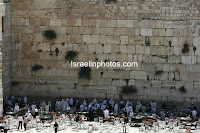The entire Western Wall is 489 meters long and can be divided into four sections:
1. The Southern Wall area is approximately 80 meters long.
2. The Kotel Plaza where people come to pray is 80 meters long.
3. The Western Wall Tunnel was originally explored by two British archaeologists: Charles Wilson, in 1864, and Charles Warren, in 1867-1870. The two archaeologists found that the Wall's length was approximately 320 meters and that some structures from the Temple period still existed.
4. An aqueduct was found near the northern part of the Wall. The aqueduct was used during the time of the Maccabbees, at about 150 BCE.
If we examine the Wall, we see three distinct layers:
The lower part has great stones in the typical Herodian Style with drafted margins. They formed part of the retaining wall built by Herod the Great in 20BC. Originally such stones went all the way to the top, which had pilasters at regular intervals; evidence from the excavations is confirmed by the intact Herodian wall of the Tomb of the Patriarchs at Hebron. The part projecting above the esplanade was pushed outwards in the Roman destruction of the Temple in 70CE. A large corner stone with a typical Herodian profile had been found during the 1970s, lying in the street below the southwestern corner of the Temple Mount. On this stone a Hebrew inscription, partially preserved, is carved: "To the trumpeting place to…" The most likely reconstruction of the missing ending of the inscription is "proclaim" or "separate". The stone had stood at the top of south-western corner of the Temple Mount, from where the Temple priests announced the onset of the Sabbath (on Friday evenings).
The Umayads restored this layer in the seventh century, and again after the great earthquake of 1033 (with much smaller stones).
At the top are smallish uniform stones, attributed to repair work by Sir Moses Montefiore in 1866.
In the 1967, at the time of the Six Day War, Israel retook the Old City of Jerusalem, including the Temple Mount and the Western Wall.
The Western Wall is the most holy place accessible to the Jewish people.
The English term "Wailing Wall" or its equivalent in other languages dates from much later. In fact, despite its hoary sound, "Wailing Wall" is a strictly 20th-century English usage introduced by the British after their conquest of Jerusalem from the Turks in 1917. In the 19th century, when European travelers first began visiting Palestine in sufficient numbers to notice the Jews there at all, the Western Wall was commonly referred to as "the Wailing Place". The term "Wailing Wall" is not used in Hebrew.





